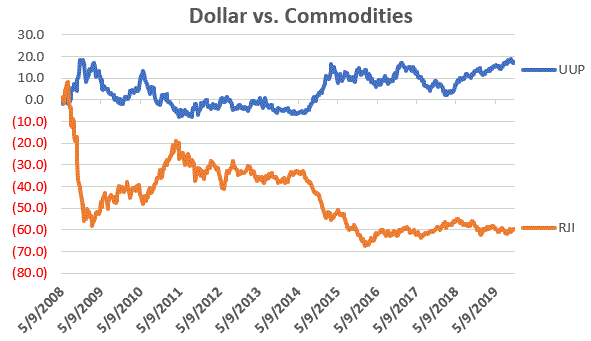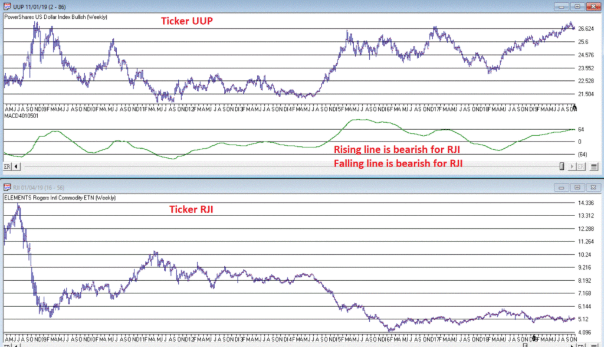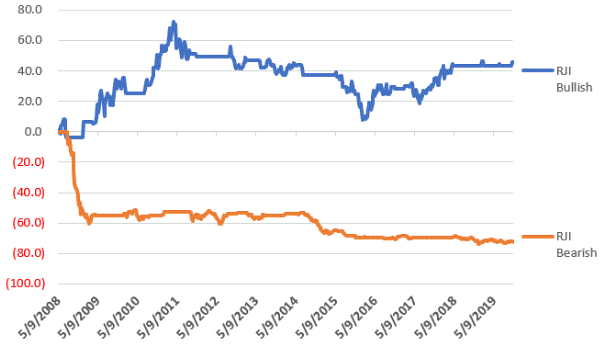I keep seeing headlines about the “imminent” re-emergence of commodities as a viable investment as an asset class. And as I wrote about here, I mostly agree wholeheartedly that “the worn will turn” at some point in the years ahead, as commodities are historically far undervalued relative to stocks.
The timing of all of this is another story. Fortunately, it is a fairly short and simple story. In a nutshell, it goes like this:
The End
Well not exactly.
The 2019 Anomaly
The year 2019 was something of an anomaly as both the U.S. dollar and precious metals such as gold and silver rallied. This type of action is most unusual. Historically, gold and silver have had a highly inverse correlation to the dollar. So the idea that both the USD AND commodities (including those beyond precious metals) will continue to rise is not likely correct.
Commodities As An Asset Class
When we are talking “commodities as an asset class” we are talking about more than just metals. We are also talking about more than just energy products.
The most popular commodity ETFs are DBC and GSG, which are more heavily traded than most others. And they are fine trading vehicles. One thing to note is that both (and most other “me too” commodity ETFs) have a heavy concentration in energies. This is not inappropriate given the reality that most of the industrialized world (despite all the talk of climate change) still runs on traditional fossil fuel-based energy.
But to get a broader picture of “commodities as an asset class” I focus on ticker RJI (ELEMENTS Linked to the Rogers International Commodity Index – Total Return) which diversifies roughly as follows:
Note that these allocations can change over time, but the point is that RJI has much more exposure beyond the energy class of assets than alot of other commodity ETFs.
RJI Vs. The Dollar
As a proxy for the U.S. dollar we will use ticker UUP (Invesco DB US Dollar Index Bullish Fund). Figure 1 displays the % gain/loss for UUP (blue line) versus RJI (orange line) since mid-2008.

Figure 1 – UUP versus RJI; Cumulative Return using weekly closing prices; May-2008-Sep-2019.
- Since May of 2008 UUP has gained +17.2%
- Since May of 2008 RJI has lost -60%
The correlation in price action between these two ETFs since 2008 is -0.76 (a correlation of -1.00 means they are perfectly inverse), so clearly there is (typically) a high degree of inverse correlation between the U.S. dollar and “commodities”.
Next, we will apply an indicator that I have dubbed “MACD4010501” (Note to myself: come up with a better name). The calculations for this indicator will appear at the end of the article (but it is basically a 40-period exponential average minus a 105-period exponential average). In Figure 2 we see a weekly chart of ticker UUP with this MACD indicator in the top clip and a weekly chart of ticker

RJI in the bottom clip.Figure 2 – UUP with Jay’s MACD Indicator versus ticker RJI
Interpretation is simple:
- when the MACD indicator applied to UUP is declining, this is bullish for RJI
- when the MACD indicator applied to UUP is rising, this is bearish for RJI.
Figure 3 displays the growth of equity achieved by holding RJI (using weekly closing price data) when the UUP MACD Indicator is declining (i.e., RJI is bullish blue line in Figure 3) versus when the UUP MACD Indicator is rising (i.e., RJI is bearish orange line in Figure 3).

Figure 3 – RJI cumulative performance based on whether MACD indicator for ticker UUP is falling (bullish for RJI) of rising (bearish for RJI)
In Sum:
- RJI gained +45.8% when the UUP MACD indicator was falling
- RJI lost -72.3% when the UUP MACD indicator was risingThe bottom line is that RJI rarely makes much upside headway when the UUP MACD Indicator is rising (i.e., is bearish for RJI).
Summary
Commodities as an asset class are extremely undervalued on a historical basis compared to stocks. However, the important thing to remember is that “the worm is unlikely to turn” as long as the U.S. Dollar remains strong.
So, keep an eye on the U.S. Dollar for signs of weakness. That will be your sign that the time may be coming for commodities.
